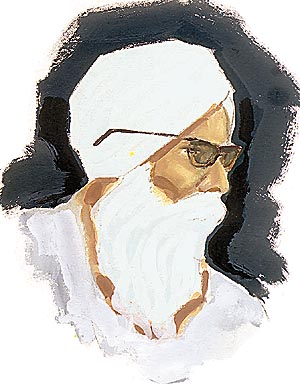IN his secluded studio Sundaram, Shivam, Satyam in Andretta, Himachal Pradesh, an ageing old man was braving ill-health to complete a portrait of Bhagat Ravi Das. Unfortunately, the artist died before completing his painting, and thus the world was deprived of yet another masterpiece from the brush of Sobha Singh, who was to Sikh art what Raja Ravi Varma was to Hindu art.
 Born on November 27, 1901, to Deva Singh, a military man, and Ichchran Devi, Sobha Singh had a very unhappy childhood, mainly because of his strained relationship with his disciplinarian father. As far as formal education was concerned, Sobha Singh studied only up to class five. He was basically a self-taught man, though he did complete a one-year diploma in Art and Crafts from Industrial School, Amritsar, in 1915. From 1919 to 1923 he was Head Draughtsman in the Indian Army stationed in Baghdad. There he was influenced by local customs and this inspired him to paint legends like Lala Rukh and Omar Khayam. He also got exposed to the work of some British artists of the Royal Academy. One Colonel G. D. Tale showed great interest in his work, and even encouraged him. In due course, The London Illustrated News printed a painting by Sobha Singh that depicted a colourful pageant.
Born on November 27, 1901, to Deva Singh, a military man, and Ichchran Devi, Sobha Singh had a very unhappy childhood, mainly because of his strained relationship with his disciplinarian father. As far as formal education was concerned, Sobha Singh studied only up to class five. He was basically a self-taught man, though he did complete a one-year diploma in Art and Crafts from Industrial School, Amritsar, in 1915. From 1919 to 1923 he was Head Draughtsman in the Indian Army stationed in Baghdad. There he was influenced by local customs and this inspired him to paint legends like Lala Rukh and Omar Khayam. He also got exposed to the work of some British artists of the Royal Academy. One Colonel G. D. Tale showed great interest in his work, and even encouraged him. In due course, The London Illustrated News printed a painting by Sobha Singh that depicted a colourful pageant.
He came back from Baghdad and started working in Lahore. After Partition, he was forced to leave Lahore, and he landed with his wife in Andretta, a picturesque valley, in Palampur district. It was in this valley that he gave us some of his finest works, especially the portraits of the Sikh Gurus.
Artist Mehar Singh, perhaps the only surviving disciple of Sobha Singh, remembers his guru nostalgically, "Ustadji once said , 'In the beginning I used to feel that famous lovers like Sohni Mahiwal and Heer Ranjha were worthy of reverence, so I devoted my work to them. Then I felt that bhagats deserve to be revered so I painted them, but as time passed I came to the conclusion that though lovers and bhagats need to be revered, the Guru Sahibaans deserve the highest honour and reverence'. Beauty was every thing to him, and he went to the extent of rephrasing the famous Satyam, Shivam Sundaram as Sundaram, Shivam, Satyam."
The influence of the Bengal School is quite evident on his style. "If you study his work carefully," observes artist and critic Prem Singh, "you would notice that although Sobha Singh's medium was oil, yet his technique resembles the wash paintings produced by the artists of the Bengal School. And like other Bengal paintings his work gives the impression of relief work. The use of light is romantic, therefore, his paintings lack the depth, dimension, and drama that we generally observe in the works of the European masters."
What Sobha Singh painted after Independence is available in various museums and galleries, but no serious effort has been made to recover or even locate the 200- odd paintings that were left behind in Lahore after Partition.Not many people know that Sobha Singh's highly popular Sohini Mahival has many versions, and one, if it has survived the frenzy of partition, should be somewhere in Pakistan.
Recognising Sobha Singh's contribution to Indian art, the President conferred on him the Padama Shree in 1983, the Punjabi University awarded him a doctorate, and the Ministry of Broadcasting and the BBC made a film on his life. The only organisation that did not take notice of him is the Central Lalit Kala Akademi, and sadly only four books are available on him. Meanwhile, the unfinished portrait of Bhagat Ravi Das reminds visitors of the great master who once worked in this dreamy valley.
http://www.tribuneindia.com/2000/20000312/spectrum/main2.htm
No comments:
Post a Comment